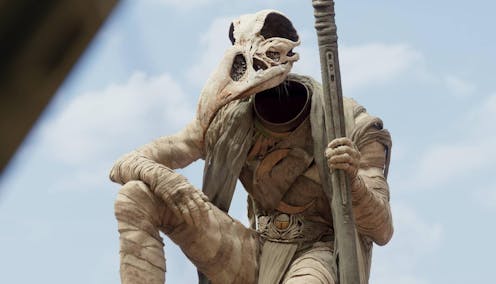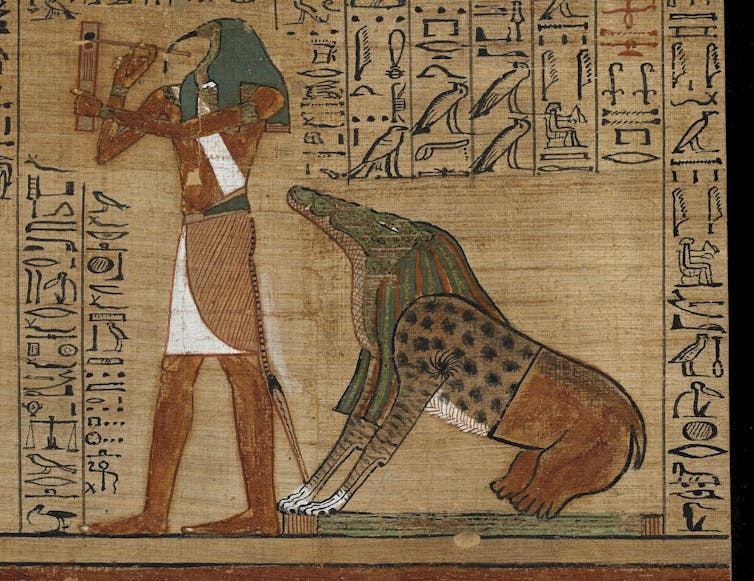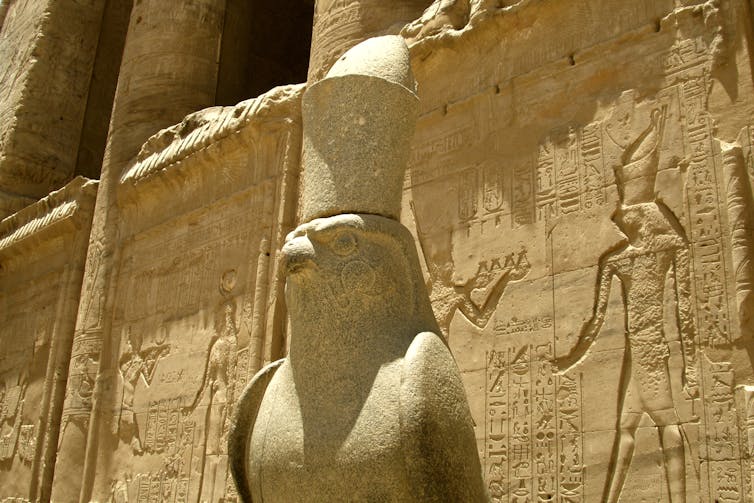
Marvel’s Moon Knight follows Steven Grant who, despite living quietly as a museum gift shop employee, finds himself drawn into the strange world of Egyptian gods. He discovers that he has other personalities – mainly Marc Spector, a human vessel who is being used to carry out the will of the moon god, Khonshu.
Steven and Marc (both played by Oscar Isaac) struggle to work together to defeat the plans of Khonshu’s former host, Arthur Harrow (Ethan Hawke), who is leading the followers of another god, Ammit.
Part of the fun of watching adaptations of Ancient Egypt for me is analysing the historical content and Moon Knight succeeds in retaining the spirit of the Ancient Egyptian pantheon. While some aspects have been altered for dramatic effect, the six-part series has been well researched and remains quite faithful to the original mythology.
One of its selling points is that it doesn’t simply tread over old ground but brings lesser-known gods to the fore. The result is a show that has the unusual quality of entertaining a popular audience while also keeping the specialists happy.
Khonshu
Khons(h)u, or Khons, was an moon god, known in the age of the pyramids as a violent, blood-thirsty deity. This is perhaps due to his having possibly existed before the state of Egypt was formed, when settlers in the Nile Valley were adapting to their new environments as they moved in and vied for supremacy.
Khonshu mellowed over time, but remained powerful, and is most commonly associated with the gods of the capital city of Thebes, including his father Amun, king of the gods. Khonshu was also associated with time and his name – khenes, “traveller” – likely relates to the journey of the moon through the night sky.
He is usually shown as a falcon-headed man, or a young man in a shroud-like garment. In the series, Khonshu is a tall figure commandingly voiced by F Murray Abraham (and performed by Karim el-Hakim), with a terrifyingly large bird skull for a head and carrying a moon-topped staff.
Ammit
Probably best known as the demon who sits at the foot of the scales in the Hall of Judgement in the Book of the Dead, a set of spells which assist the dead in reaching the afterlife. She is part lion, part crocodile, part hippopotamus (the three animals considered to be the most dangerous in Ancient Egypt). She patiently awaits the heart of the dead, weighed against the feather of truth, should they be found “guilty” by the scales. Her name means “the devourer”. She prevents those who are not worthy from entering the afterlife by consuming their heavy hearts, so that they can’t live on.

Moon Knight’s Ammit (voiced by Sara Mubarak) has an imposing crocodilian form. In the series, she doesn’t want to wait for death but to dole out judgement before people can do wrong. However, she has been trapped in a stone idol so her followers are searching for her tomb to resurrect her and restore her to her place as the true arbiter of justice.
Taweret
A goddess of the household, Taweret (“the great one”) has a hippopotamus-crocodile hybrid form, sometimes with the claws of a lion. She is fearsome with her bared teeth and often brandishes a blade, to keep away dark forces and protect the vulnerable – pregnant women, new mothers, children – through prayers, spells and amulets. She carries out her protective duties in Moon Knight in the shape of a much friendlier hippo (portrayed by Antonia Salib). Her “Hi!” on meeting Steven and Marc is comically high-pitched coming from her looming form. She is as steadfast and determined as her mythological counterpart (minus the gnashing teeth), helping Marc and Steven in their tasks. In the series, she takes on a role more traditionally held by Anubis, god of mummification, by guiding people into the afterlife.
Other members of the Ancient Egyptian pantheon feature in the chamber of the gods, but have much less screen time. Nevertheless, they play a big role in the movement of the plot, as their judgements have a pivotal effect on how the rest of the show plays out (no spoilers). They are portrayed in the series in the form of their human hosts. In mythology, they are some of the most significant gods of all.
Osiris
Lord of the dead, king of the underworld, benign guardian of the afterlife, Osiris is shrouded, wearing a white crown with a cobra, which symbolises rule over the southern half of Egypt. In mythology, he was the first king, and the first to die. He was resurrected by his wife, Isis, and took his place as the personification of the deceased pharaoh, becoming the first mummy and representation of hope in life after death. He is green or black-skinned to represent new life. He is also a god of agriculture and fertility. In the series, he pronounces the gods’ decisions in the chamber through his human host.
Horus

Horus, son of Osiris and Isis, avenged his father’s murder and took on the role of king, representing the living pharaoh. He battled Seth, his father’s brother, to retrieve the throne and restore order – which is why Horus is heavily associated with the ruling king. Horus is usually shown as a falcon or falcon-headed man. With his father Osiris, they represent the divine nature of the king.
Hathor
A goddess of love, music, childbirth and dancing, Hathor is often shown as a cow or as a woman with a cow’s head, ears or horns. She is a very ancient goddess, perhaps dating back to before state formation in Egypt. Hathor is a protector, usually benevolent but vengeful when needed. She was worshipped widely in Egypt and abroad, with cults spreading up the Levant and into Sinai, earning her the title “mistress of foreign lands”.
Claire Gilmour does not work for, consult, own shares in or receive funding from any company or organisation that would benefit from this article, and has disclosed no relevant affiliations beyond their academic appointment.
This article was originally published on The Conversation. Read the original article.







